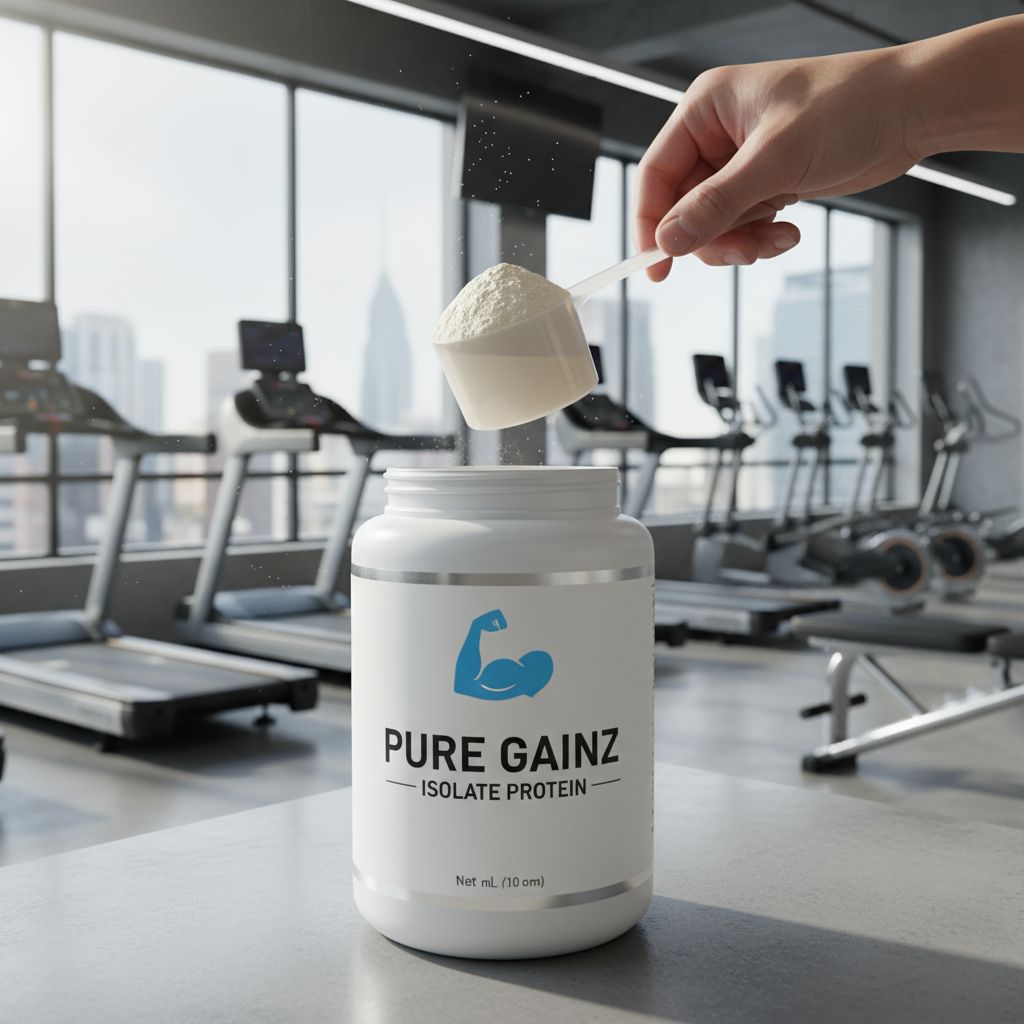If you've scrolled through Instagram, TikTok, or visited your local gym lately, you've probably noticed something undeniable: whey protein is everywhere. Once relegated to hardcore bodybuilders chugging chalky shakes in dimly lit weight rooms, whey protein has undergone a mainstream transformation that's nothing short of remarkable. The global market, valued at a staggering $12.5 billion in 2024, is projected to skyrocket to $31.3 billion by 2035, growing at an impressive 8.70% annually. But what's fueling this protein-powered revolution?
From viral fitness influencers blending protein into coffee to clean-label warriors demanding transparency, to post-pandemic immunity seekers—whey protein has become the unofficial supplement of our health-obsessed era. This isn't just another wellness fad destined to fade; it's a seismic shift in how we approach nutrition, convenience, and performance. Let's dive deep into the explosive factors making whey protein the undisputed king of supplements in 2025.
The Gen Z and Millennial Fitness Phenomenon
Gym culture isn't just trending—it's the new social currency. Gen Z and millennials have transformed fitness from a chore into a lifestyle, and whey protein sits at the epicenter of this movement. A staggering 63% of Gen Z and younger millennials are now adding protein shakes to their daily routines, compared to significantly lower adoption rates among older generations.
The numbers tell the story: According to the Ministry of Youth Affairs and Sports, government initiatives like the Fit India Movement have institutionalized fitness culture across India, recommending 30-60 minutes of daily physical activity. This isn't happening in isolation—social media has amplified gym culture into a full-blown phenomenon. On platforms like Instagram and TikTok, the hashtag #wheyprotein has generated over 6.4K uses in just the last seven days, with related fitness hashtags like #bodybuilding reaching 117 million posts.
"It's a social media thing because social media hops on what's popular and what's popular right now is going to the gym," explains Isaac Vance, a gym employee working toward his personal trainer's license. For this generation, protein consumption isn't just about nutrition—it's about identity, community, and belonging to a movement that values strength, performance, and aesthetic goals.
The Science Still Reigns Supreme
While trends come and go, whey protein's dominance rests on an unshakeable foundation: science. Even as plant-based alternatives and novelty protein sources emerge, whey continues to outperform in critical metrics that actually matter for results.
Complete Amino Acid Profile: Whey contains all nine essential amino acids, with exceptionally high levels of leucine—the primary trigger for muscle protein synthesis. This makes it the gold standard for post-workout recovery.
Lightning-Fast Absorption: Whey digests rapidly and enters the bloodstream quickly, delivering amino acids precisely when muscles need them most—during the critical recovery window after training.
Superior Bioavailability: With one of the highest Protein Digestibility Corrected Amino Acid Scores (PDCAAS), whey ensures your body actually uses the protein you consume, not just processes and discards it.
Research published in 2025 demonstrated that whey protein isolate resulted in significantly higher rates of myofibrillar muscle protein synthesis compared to concentrate, underscoring the importance of protein quality. For athletes and fitness enthusiasts, this isn't marketing hype—it's measurable, reproducible science that delivers tangible results.
The Post-COVID Immunity Connection
The pandemic fundamentally altered how we think about health, and whey protein emerged as an unexpected player in the immunity conversation. Whey proteins contain bioactive compounds like lactoferrin, immunoglobulins, and lysozyme that have demonstrated antiviral properties.
Groundbreaking research found that whey proteins from both human breast milk and bovine sources inhibited SARS-CoV-2 and pangolin coronavirus by blocking virus entry and replication, with effective concentrations of just 0.13-0.5 mg/ml of total protein. While whey protein doesn't prevent or cure COVID-19, studies suggest it can enhance the body's antioxidant defenses by stimulating glutathione production—one of the body's primary defense molecules against oxidative stress.
Post-pandemic, consumers aren't just seeking muscle gains; they want holistic health protection. Whey protein's ability to support immune function while delivering performance benefits has positioned it as a dual-purpose supplement for an increasingly health-conscious population.
Clean Label Revolution: Transparency Wins
Modern consumers have become label detectives, and they're not impressed by marketing buzzwords—they want proof. The clean label movement has transformed from a niche preference into a mainstream demand, fundamentally reshaping the whey protein landscape.
What consumers are demanding:
Natural protein sources like grass-fed whey
No artificial sweeteners, colors, or flavors
Transparent ingredient lists with recognizable components
Third-party testing and certifications
Full supply chain disclosure
A study revealed that 65% of consumers globally consider protein content their top criterion when purchasing packaged food or beverages, and they're increasingly scrutinizing the source and processing methods. Brands like Transparent Labs, AS-IT-IS, and others have capitalized on this trend by offering minimally processed, lab-tested whey with complete transparency.
The clean label trend isn't just about what's excluded—it's about trust. "Clean label encompasses many concepts: simple and well-known ingredients, GM-free, no preservatives, a short list of ingredients, simple manufacturing processes," according to industry analysis. In Europe, 69% of consumers find there are too many artificial ingredients in sports nutrition products, driving demand for cleaner alternatives.
The Metabolic Health and Weight Loss Wave
Whey protein has transcended the gym to become a powerful tool in the battle against obesity, metabolic syndrome, and weight management—a transition that's opened up entirely new consumer segments.
The weight loss mechanism is elegantly simple yet remarkably effective. Protein promotes satiety by increasing hormones like GLP-1 while reducing hunger signals, leading to smaller portion sizes and reduced snacking. A 2022 study found that women taking whey protein hydrolysate showed significant decreases in body fat compared to controls, with the greatest reductions in weight, BMI, and overall body fat.
Perhaps most intriguingly, whey protein has emerged as a metabolic ally for women with PCOS (Polycystic Ovary Syndrome)—a condition affecting millions worldwide. Research published in 2021 demonstrated that whey supplementation improved insulin sensitivity, enhanced glucose handling, and provided glycemic homeostatic effects in women with PCOS. The protein works by:
Improving insulin sensitivity and lowering blood sugar
Increasing satiety hormones like GLP-1
Preserving lean muscle during fat loss
Supporting hormonal balance by stabilizing blood sugar
"High protein diets increase muscle mass, which can enhance control of blood glucose, lipids, and insulin resistance," notes research on PCOS management. This expanded application has introduced whey protein to health-conscious women who may never set foot in a gym but are seeking metabolic health solutions.
Social Media: The Viral Protein Revolution
If science provides the foundation, social media is the megaphone amplifying whey protein into mainstream consciousness. Fitness influencers, dietitians, and lifestyle creators have transformed protein consumption from a supplement routine into shareable content that racks up millions of views.
The TikTok and Instagram Effect has been transformative. "Whey protein coffee" videos alone have generated millions of views, pushing curious consumers straight to checkout carts. Fitness influencers share "What I Eat in a Day" content featuring whey-based recipes—from protein pancakes to overnight oats—normalizing protein supplementation as part of everyday eating, not just post-workout recovery.
The social proof is staggering: related hashtags like #fitness (145.8M posts), #bodybuilding (117M posts), #gymlife (64.9M posts), and #muscle (63.2M posts) create an ecosystem where whey protein features prominently. This isn't traditional advertising—it's peer-to-peer influence at scale, with real people showing real results.
Celebrity and athlete endorsements have further legitimized whey protein. MS Dhoni's endorsement of Explosive Whey, Bollywood actors like Tiger Shroff and John Abraham promoting brands like Myprotein, MuscleBlaze, and GNC—these partnerships signal that whey protein isn't just for bodybuilders anymore; it's for anyone pursuing excellence.
Convenience in a Chaotic World
In our hyper-connected, time-starved reality, convenience isn't a luxury—it's a necessity. Whey protein delivers complete nutrition in formats that fit seamlessly into the busiest lifestyles.
The convenience factor manifests in multiple ways:
Ready-to-Drink Innovations: Brands have launched RTD protein shakes requiring zero preparation—just grab, shake, and consume. Products like Optimum Nutrition's Gold Standard RTD deliver 24g of protein with immune-supporting vitamins in convenient cartons. India's Amul has entered the space with High Protein Blueberry Shake offering 20g of protein in a 200ml PET bottle—no mixing, no mess.
Flavor Revolution: Gone are the days of chalky, unpalatable protein shakes. Today's whey proteins come in gourmet flavors ranging from Dalgona Coffee and Kesar Badam Pista to innovative clear whey options in fruity flavors like Nimbu Pani, Mango Peach, and Strawberry Kiwi. This flavor diversity transforms protein consumption from a chore into an enjoyable beverage experience.
Meal Replacement Versatility: Busy professionals and parents are incorporating whey into breakfast smoothies, mid-day snacks, and post-workout recovery—replacing time-intensive meal preparation with nutrition-packed convenience.
With busy lifestyles and limited time for meal preparation, whey protein offers a convenient way to meet daily protein needs," summarizes industry analysis. For Indians whose traditional diets are often carbohydrate-heavy and protein-deficient, whey supplements provide an efficient solution to bridge the nutritional gap.
E-Commerce and Direct-to-Consumer Disruption
The digital transformation of protein sales has democratized access and disrupted traditional retail models. E-commerce now contributes roughly 45% of North American whey protein distribution, with similar trends emerging globally.
India presents a particularly compelling case study. In 2024, Parag Milk Foods invested ₹300 crore to expand its Avvatar whey protein line, targeting 20-25% market share by FY28, with one-third of sales already coming from e-commerce platforms. This digital-first strategy bypasses traditional retail markups, offering consumers better pricing and unprecedented product variety.
The DTC revolution has empowered brands to:
Build direct relationships with consumers through subscription models
Offer personalized nutrition plans and customized protein blends
Leverage influencer marketing and targeted social media advertising
Provide detailed product information and third-party testing results
Create loyalty programs that increase customer lifetime value
Platforms like Amazon, Flipkart, HealthKart, and MyProtein have become protein shopping destinations, with user reviews, comparison tools, and educational content guiding purchasing decisions. This transparency and accessibility have accelerated market growth, particularly among younger, digitally native consumers.
The Controversy: Lead Contamination Concerns
No discussion of whey protein's 2025 landscape would be complete without addressing the elephant in the room: heavy metal contamination. In October 2025, Consumer Reports published alarming findings that sent shockwaves through the industry.
The investigation tested 23 protein powders and shakes, finding that more than two-thirds contained lead levels exceeding 0.5 micrograms per serving—the recommended daily safety limit. Perhaps most concerning, lead levels were higher than those found 15 years ago when Consumer Reports first tested these products.
The breakdown by protein type:
Plant-based proteins contained the highest lead levels—approximately nine times more than dairy-based proteins like whey
Whey and dairy proteins contained the lowest lead levels among all categories tested
Half of all tested products still had contamination high enough to warrant caution against daily use
Products like Naked Nutrition's Vegan Mass Gainer and Huel's Black Edition were categorized as "products to avoid" due to elevated contamination. However, whey protein emerged relatively favorably in this analysis, with significantly lower contamination than plant-based alternatives—though consumers are still advised to exercise caution and select third-party tested products.
This controversy has actually accelerated the clean label movement, with consumers demanding even greater transparency, third-party certifications (NSF, Informed Choice, Informed Sport), and verifiable testing results. Brands responding proactively to these concerns are positioning themselves as trustworthy leaders in an increasingly scrutinized market.
Innovation: Clear Whey and Flavor Frontiers
Innovation has kept whey protein fresh and exciting, preventing category fatigue even as the market explodes. Clear whey protein—perhaps the most significant innovation in recent years—has fundamentally changed how people experience protein supplementation.
Unlike traditional creamy, milk-based shakes, clear whey dissolves into a light, refreshing, juice-like beverage that appeals to consumers who dislike heavy textures, particularly in warm weather or during workouts. The advantages are compelling:
Light and refreshing: Similar to fruit juice rather than milkshakes
High-quality protein: Same premium protein benefits with whey isolate
Digestive ease: Often lactose-free and low in fat, easier on sensitive stomachs
Versatility: Appeals to fitness enthusiasts and casual consumers alike
Brands have also pushed flavor boundaries aggressively. Dymatize offers 15+ unique flavors including cereal-inspired options like Dunkin' Glazed Donut. Regional brands cater to local palates with flavors like Kesar Thandai and Blue Tokai Coffee. This flavor innovation transforms protein consumption from a nutritional obligation into an anticipated treat.
Personalized Nutrition and AI Integration
The future of whey protein isn't one-size-fits-all—it's hyper-personalized. AI-driven nutrition platforms like ZOE and DayTwo are pioneering approaches that tailor protein recommendations based on individual biological markers, gut microbiome composition, and real-time metabolic responses.
The personalization ecosystem includes:
Wearable integration: Fitness apps connecting with Apple Watch, Fitbit, and Garmin automatically track protein needs based on activity levels and recovery metrics
Continuous glucose monitors: Providing real-time feedback on how protein consumption affects blood sugar stability
AI-powered recommendations: Analyzing workout intensity, sleep quality, and stress levels to optimize protein timing and dosage
Customized blends: Brands offering personalized protein formulations based on body type, fitness goals, and dietary preferences
"AI has the potential to deliver individualized nutrition recommendations through multi-omics integration and behavioral modeling," according to research on AI in personalized nutrition. This technological convergence is transforming whey protein from a generic supplement into a precision nutrition tool calibrated to individual needs.
Looking ahead, experts predict whey blends tailored to hormonal cycles for women, microbiome-specific protein formulas, and dynamic protein dosing based on real-time biometric data. This personalization trend will deepen consumer engagement and justify premium pricing for brands offering genuine customization.
Sustainability and Ethical Sourcing
Conscious consumers—particularly Gen Z and millennials—increasingly evaluate purchases through an ethical lens, and whey protein has responded with sustainable sourcing initiatives.
Grass-fed whey protein has emerged as the premium choice, offering:
Enhanced nutritional profile: Higher omega-3 fatty acids and CLA (conjugated linoleic acid)
Animal welfare: Cows grazing freely on natural pastures 150-180 days annually
Lower carbon footprint: Sustainable farming practices supporting biodiversity and soil health
Transparent sourcing: Complete traceability from pasture to powder
Ireland has positioned itself as the gold standard for grass-fed dairy, with its alkaline limestone-rich grasslands creating ideal conditions for year-round grazing and producing some of the lowest carbon-emitting dairy operations globally. Brands like Protelicious and AGN Roots have built their entire identity around grass-fed sourcing, appealing to eco-conscious consumers willing to pay premium prices for sustainability.
"Support the aim for ZERO Carbon Emissions!" proclaims AGN Roots, recognizing that informed consumers hold the purchasing power to drive industry transformation toward sustainable practices.
The Protein Economy: Market Dynamics
The explosive growth trajectory isn't slowing—if anything, it's accelerating. Multiple market analyses project continued expansion driven by converging demographic, technological, and cultural factors.
Key market dynamics:
Geographic Expansion: Asia-Pacific is the fastest-growing regional market, fueled by rising fitness culture and middle-class affluence. India's whey protein market, valued at $180 million in 2024, is projected to reach $240 million by 2033.
Product Diversification: Whey protein has expanded beyond powders into protein bars, baked goods, ready-to-drink beverages, collagen hybrids, and even beauty powders.
Application Expansion: Beyond sports nutrition, whey is penetrating clinical nutrition, infant formula, pharmaceutical applications, and functional beverages.
Competitive Landscape: Major players including Glanbia, Arla Foods, Fonterra, and Lactalis Ingredients are investing heavily in R&D, production capacity, and marketing to capture market share.
Distribution Evolution: Online retail and DTC channels now account for 27% of global whey protein sales, fundamentally altering distribution economics.
The United States alone produced 42.873 million pounds of whey protein concentrate in June 2025, representing 4.8% growth over 2024, with whey protein isolate production reaching 18.077 million pounds—an 11.1% increase. This production scale reflects genuine consumer demand, not speculative inventory buildup.
Expert Perspectives: What the Professionals Say
Industry professionals consistently emphasize that whey protein's dominance rests on efficacy, convenience, and versatility rather than marketing hype alone.
"For athletic lifestyles, whey is still the preferred protein source because of the kinetics and muscle-building benefits it carries," report trainers and wellness coaches across India. Dietitians recommend whey not just for muscle building but for weight loss, PCOS management, and metabolic function improvement.
Nutritionists note that while plant-based proteins have improved significantly, whey still outperforms in bioavailability, taste, texture, and research backing. The clinical trust built over decades of research gives whey a legitimacy that emerging alternatives struggle to match.
"Science has shown again and again that a good plant protein blend works just as well as whey for repairing and building strong muscles," acknowledges plant protein advocates, yet they concede that whey's complete amino acid profile and faster absorption make it the gold standard for performance-focused consumers.
The Bottom Line: Why Whey Wins
Whey protein's explosive 2025 trajectory isn't accidental—it's the convergence of unassailable science, cultural zeitgeist, technological innovation, and consumer demand for transparency, convenience, and results.
From Gen Z fitness warriors documenting every rep on Instagram to busy professionals seeking meal replacement solutions, from women managing PCOS to post-pandemic immunity seekers, from clean-label advocates to AI-powered nutrition optimizers—whey protein has become the universal supplement that transcends demographic boundaries.
The contamination concerns have paradoxically strengthened the category by accelerating quality standards and third-party testing. The innovation in flavors, formats, and personalization keeps the category fresh. The sustainability initiatives address ethical concerns. The science remains unimpeachable.
Whey protein in 2025 isn't just trending—it's fundamental. It's the intersection of performance, convenience, science, and community that defines modern health culture. Whether you're a gym regular, a weekend warrior, or simply someone trying to hit daily protein goals without cooking another chicken breast, whey protein has become an indispensable tool in the pursuit of wellness.
The question isn't why whey protein is trending—it's why it took this long for the rest of the world to catch up to what athletes have known for decades: when it comes to protein supplementation, whey still reigns supreme.



